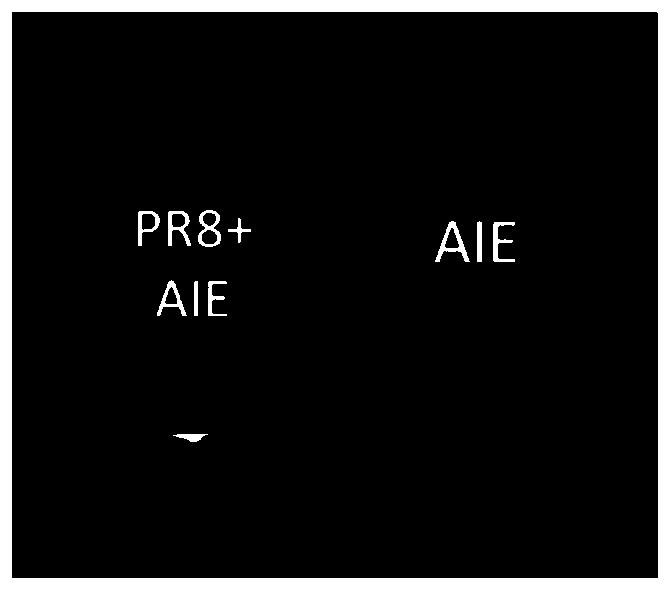Rapid influenza virus labeling and tracing method based on aggregation-induced emission molecules
A technology for aggregation-induced luminescence and influenza virus, which is applied in the fields of virology and biological sciences, can solve the problems of cumbersome steps, low labeling efficiency, and insufficient brightness, and achieve the effect of simple labeling process, overcoming fluorescence quenching, and little impact on virus activity
- Summary
- Abstract
- Description
- Claims
- Application Information
AI Technical Summary
Problems solved by technology
Method used
Image
Examples
Embodiment 1
[0025] A rapid labeling and tracing method for influenza virus based on aggregation-induced luminescent molecules, the specific steps are as follows:
[0026] 1) Inoculate HeLa cells in good condition into a 15mm glass-bottom culture dish until the cell density reaches 50%;
[0027] 2) Take the molecule n-tetraphenylethylene (TPE) with aggregation-induced emission (AIE) properties10 -6 μM;
[0028] 3) Ultrasound at a power of 50 watts for 20 minutes;
[0029] 4) Centrifuge at 12,000 rpm for 10 minutes, and take 5 microliters of supernatant;
[0030] 5) Take a sterile 0.2 ml centrifuge tube, add 5 microliters of purified influenza virus and 5 microliters of n-tetraphenylethylene supernatant and mix well, so that n-tetraphenylethylene is adsorbed on the surface of influenza virus.
[0031] 6) Take a sterile 1.5 ml centrifuge tube, add 5 microliters of influenza virus labeled with aggregation-induced luminescent molecules and dilute to 1 ml with serum-free medium DMEM;
[003...
Embodiment 2
[0035] A rapid labeling and tracing method for influenza virus based on aggregation-induced luminescent molecules, the specific steps are as follows:
[0036] 1) Inoculate HeLa cells in good condition into a 15mm glass-bottom culture dish until the cell density reaches 50%;
[0037] 2) Take the molecule n-tetraphenylethylene (TPE) with aggregation-induced emission (AIE) properties10 -5 μM;
[0038] 3) Ultrasound with a power of 60 watts for 30 minutes;
[0039] 4) Centrifuge at 13,000 rpm for 10 minutes, and take 10 microliters of supernatant;
[0040] 5) Take a sterile 0.2 ml centrifuge tube, add 10 microliters of purified influenza virus and 10 microliters of n-tetraphenylethylene supernatant and mix well, so that n-tetraphenylethylene is adsorbed on the surface of influenza virus.
[0041] 6) Take a sterile 1.5 ml centrifuge tube, add 10 microliters of influenza virus labeled with aggregation-induced luminescent molecules and dilute to 1 ml with serum-free medium DMEM; ...
Embodiment 3
[0045] A rapid labeling and tracing method for influenza virus based on aggregation-induced luminescent molecules, the specific steps are as follows:
[0046] 1) Inoculate HeLa cells in good condition into a 15mm glass-bottom culture dish until the cell density reaches 50%;
[0047] 2) Take the molecule n-tetraphenylethylene (TPE) with aggregation-induced emission (AIE) properties10 -4 μM;
[0048] 3) Ultrasound at a power of 55 watts for 26 minutes;
[0049] 4) Centrifuge at 12500 rpm for 10 minutes, and take 8 microliters of supernatant;
[0050] 5) Take a sterile 0.2 ml centrifuge tube, add 8 microliters of purified influenza virus and 7 microliters of n-tetraphenylethylene supernatant and mix well, so that n-tetraphenylethylene is adsorbed on the surface of influenza virus.
[0051] 6) Take a sterile 1.5 ml centrifuge tube, add 8 microliters of influenza virus labeled with aggregation-induced luminescent molecules and dilute to 1 ml with serum-free medium DMEM;
[0052...
PUM
 Login to View More
Login to View More Abstract
Description
Claims
Application Information
 Login to View More
Login to View More - R&D
- Intellectual Property
- Life Sciences
- Materials
- Tech Scout
- Unparalleled Data Quality
- Higher Quality Content
- 60% Fewer Hallucinations
Browse by: Latest US Patents, China's latest patents, Technical Efficacy Thesaurus, Application Domain, Technology Topic, Popular Technical Reports.
© 2025 PatSnap. All rights reserved.Legal|Privacy policy|Modern Slavery Act Transparency Statement|Sitemap|About US| Contact US: help@patsnap.com

